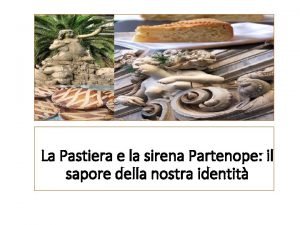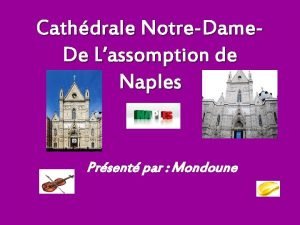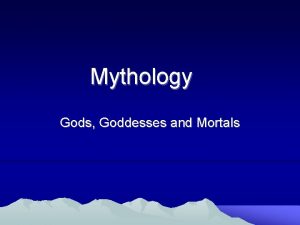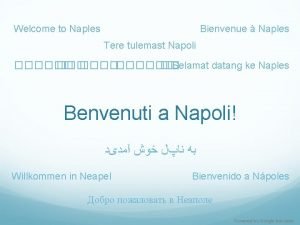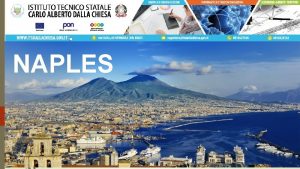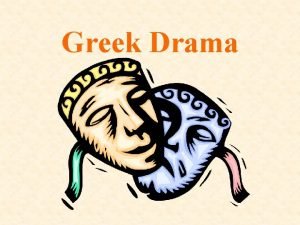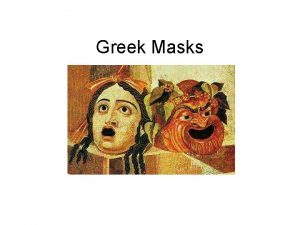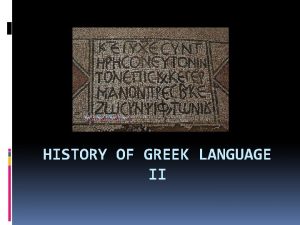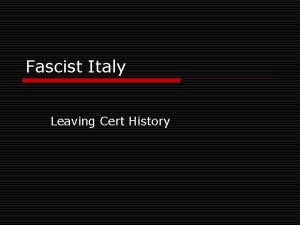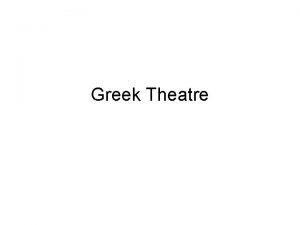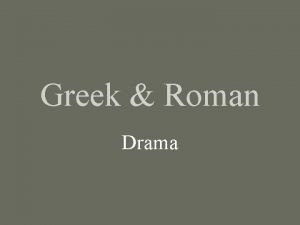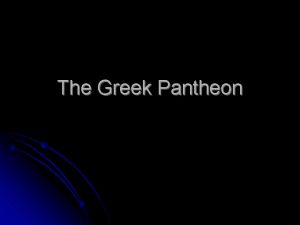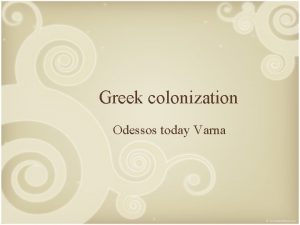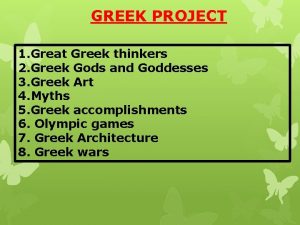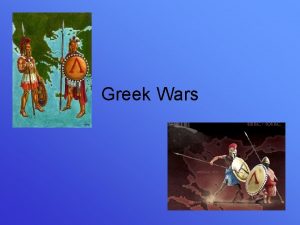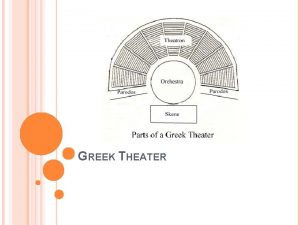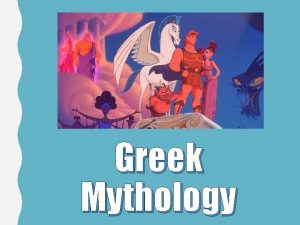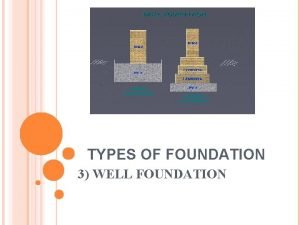Italians history Greek Naples The foundation of Partenope






















- Slides: 22

Italians history

Greek Naples. The foundation of Partenope The Monte Echia is the place where arose the Greek polis. The settlement of Partenope is built on the actual Monte Echia: the city was founded by the Cumans. Partenope was protected by a complete wall, that sheltred the city nuleus by the coast. , the port was located at the current Town Hall Square and the site took its name from the siren Partenope, which according to one of the legends lived in the Sorrento peninsula and, after hrdeath, was transported by marine currents in the place of the future Neapoli

�The new emerging power of Rome, realizing the potentiality of Neapolis and its port, manifested his expansionist aims to subract Neapolis to the influence of Greek , Cumana and Sannita power. Neapolis was conquered in 327 BC by the Romans.

• The Plinian eruption. In 79 A. D. Neapolis was shaken by a violent eruption of Vesuvius. At that time, the population, not knowing the true nature of the mountain were completely taken by surprise: in fact, Vesuvius had not given many opportunities to get to know, because for centuries it was a fully inactive volcano, in a quiescent state. Precursors of the events occurred, such as the earthquakes of 63 and 64 AD which damaged all of the city in the bay. In Neapolis also collapsed a part of the outdoor theater. The historians say that durin one of this sismic events Nerone was giving one of his show in the open space theater

On 24 August 79 A. D. Began the terrible volcanic eruption. It was observed by Pliny the Elder, who was in the nearby town of Misenum. His nephew, Pliny the Younger handed down to the posterity the terrible chronicle. After burying the nearby cities with hash and pumice , hot clouds made their appearance, Neapolis was not hit by the latter but rather was damaged by the earthquake, storm surges and heavy rains of ash. Pompeii, Herculaneum and Stabiae Oplontis and all the villages closest to the mountain were completely destroyed

�During the Roman period, the city of Naples started to expand in the direction of the natural port and out the wall border. The entire urbanistic plan changed and the Dome zone started to have a residential destination. � In the following centuries the city was rebuilt with different characteristic. In fact in order to solve the problem of degradation of some areas a great number of buildings were removed and substitued with new magnificent ones that should show the "grandeur " of Naples and hide the poverty and misery.

The Middle Ages Given a period of decline, the Middle Ages are divided into Upper and Lower Middle Ages' s . The high Middle Ages go from the fifth to the tenth century BC. During this period there weredifferent barbarian invasions. The Late Middle Ages start around 1000 BC till 1492 (America discovery) in this long period cities had new life and grew larger. In this period there were several changes as the spread of monasticism, the Crusades, and new productive jobs (bankers and craftsmen).

The Renaissance The Congress of Vienna divided Italy in various states. Soon began the first revolutionary movement for the unification of the Italian State. The riots of 1848 began the path of 'Italian independence which was achieved in 1861 with the unification of Italy thanks to patriots such as Mazzini, Cavour and Garibaldi, who, with thousands of people, went up Italy from Sicily and reliesed the southern regions from foreign domination. . Garibaldi met in Theano King Victor Emmanuel, who ruled the northern regions and welcame him as king of unified Italy. In 1871 Rome became the capital of Italy

World War I � Italy entered the war in maggio 1915 declaring war to Austria- Hungary, after having signed the Triple Entente with Britain, France and Russia. A downturn came with the defeat of Caporetto in 1917. In 1918 the first world war ended with the victory of France

World War II With the invasion of Poland by Germany 1 settembre 1939 the second world war started. On May of the same year Hitler and Mussolini entered into " the pact of steel " with which Italy undertook to support militarily Germany. Italy entered the war in 1940 preparing an attack against France. Germany proved to be very strong while the Italian army was weak. After several battles on several fronts (Greece, Albania) 's Italy abandoned its first allied Germany and Japan. The war ended in 1945 ominously.

The fascism Fascism is a political movement born in Italy in March 1919, in Milan. It was founded by Benito Mussolini, as a republican and anticlerical movement, even democratic, but just to get the consensus of the masses. Within a few months new authoritarian and undemocraticteams of action adverse to the Socialists started to their horrible job. Mussolini gained the favor of landowners and industrialists, they saw in the future dictator, the man who could stem the popular demonstrations and strikes in the factories, and stop the rise of the popular classes.

�In 1921 the fascists got 35 MPs to the Deputy chamber. In October 1922 was organized the march on Rome and the King Victor Emmanuel III relied on Mussolini's new government. In the thirties there was a stabilization of the regime, almost the entire population, willy-nilly, was now framed in fascism. The first measures again racewere published on July 14, 1938 with the "manifesto of the race "and on 14 December 1938 were enacted racial laws. The situation in two years, rushed, the Allies and the partisan forces fighted the fascist army. On July 25, 1943, Mussolini summoned the Grand Council of Fascism and was forced to dismiss. He was arrested and powers were handed over to the king. �

Italy: Geography

Italy is a geographic region of Southern Europe, hilly, bordered to the north and west by the Alps that are the major mountain chain of Italy, and situated between the Iberian Peninsula and the Balkan Peninsula. It overlooks the Mediterranean Sea and is bordered by four seas (Mar Ligurian, Tyrrhenian Sea, Ionian Sea and the Adriatic Sea. )

Italy is rich in waterways, the most important river is the Po, which crosses the Po valley and flows into the Adriatic Sea with a delta that has been declared a World Heritage Site UNESCO's. The climate is strongly influenced by the seas that surround almost every side and which constitute a reservoir of beneficial heat and humidity. In fact it determines, within the temperate zone, a particular temperate climate said mediterraneo. For the Po delta is defined as the hydraulic system of branches through which the river flows into the Adriatic Sea

In Italy there are many volcanoes: the best known are Mount Etna, the highest volcano in Europe, Mount Vesuvius and the Stromboli.

Italy is a member state of the European Union located in Southern Europe with Rome as its capital. Bounded on the north largely from the Alps, Italy is bordered to the west by France, to the north by Switzerland Austria and to the east by Slovenia. Italian is the official language and the most widely spoken, are however, recognized locally as a co-official in the following languages: French in Valle d'Aosta, Slovenian in the provinces of Trieste and Gorizia, the German province of Bolzano, Ladin ladinofoni in the municipalities of Trentino-Alto Adige. In Italy there are five independent Regions: Valle D’Aosta, Friuli Venezia Giulia, Trentino Alto Adige, Sicily, Sardinia. They are the two biggest islands of Italy too. In total in Italy there are 20 regions.

Details on the countryside. Campania is the second most populous region in Italy and has the highest population density. It is bordered by Puglia, Molise, Basilicata and Lazio. The region has a long and varied Tyrrhenian coast, and is predominantly mountainous. It is crossed by the Apennines Campano, Lucano Apennines and Antiappennino Romano-Campanian; among the main findings we have the Matese Mountains, the Mountains and the mountains of Picentinis Cilento. The region is characterized by two large plains, the Sele and the Volturno, and other flat areas such as agro-Nocerino - Sarnese. The Tyrrhenian major rivers are the Volturno and the Sele there also two lakes : the Matese and Laceno.

In the gulf of Naples there also some islands of Volcanic origin: Nisida, Procida, Vivara and Ischia, and the wonderful Island of Capri. The climate is Mediterranean with mild winters. The thermal resources (Telese Agnano, Castellammare) constitute another touristic appeal for the region. Campania is composed by 'cons 5 provinces: Naples, Avellino, Benevento, Caserta and Salerno . Not far from the coast, in the Gulf of Naples, is the Vesuvius, an active volcano particularly interesting for its history and for the frequency of its eruptions. Statistically independent. NISIDA

VIVARA PROCIDA

ISCHIA CAPRI

The climate in Italy is generally temperate. The seasons are well defined : Winter is generally cold, Spring is wet with sunny days, Summer hot and dry and autumn rainy more rarely rainy. Italy can be divided into three distinct climatic zones: NORTH: The North-Italy, or the part between the Alps and the Tuscany Appennines has a continental climate CENTRE: The Centre of Italy, Including approximately Liguria and Lazio with a temperate climate, SOUTH: The South with the main islands of Sicily and Sardinia , warm and dry climate, with little rainfall and periodic droughts The winter is never too HARD and autumn and spring have an average mild temperature
 Sirena partenope pastiera
Sirena partenope pastiera Paglalakbay ni rizal
Paglalakbay ni rizal Cathédrale notre-dame-de-l'assomption de naples
Cathédrale notre-dame-de-l'assomption de naples [email protected]
[email protected] Teddy bear museum naples
Teddy bear museum naples Naples revolution 1821
Naples revolution 1821 Dolce vita naples
Dolce vita naples Army recruiter naples fl
Army recruiter naples fl Pile foundation details
Pile foundation details Composition of urine
Composition of urine The greek miracle
The greek miracle Hình ảnh bộ gõ cơ thể búng tay
Hình ảnh bộ gõ cơ thể búng tay Lp html
Lp html Bổ thể
Bổ thể Tỉ lệ cơ thể trẻ em
Tỉ lệ cơ thể trẻ em Voi kéo gỗ như thế nào
Voi kéo gỗ như thế nào Chụp tư thế worms-breton
Chụp tư thế worms-breton Chúa sống lại
Chúa sống lại Các môn thể thao bắt đầu bằng tiếng nhảy
Các môn thể thao bắt đầu bằng tiếng nhảy Thế nào là hệ số cao nhất
Thế nào là hệ số cao nhất Các châu lục và đại dương trên thế giới
Các châu lục và đại dương trên thế giới Công thức tính thế năng
Công thức tính thế năng Trời xanh đây là của chúng ta thể thơ
Trời xanh đây là của chúng ta thể thơ
